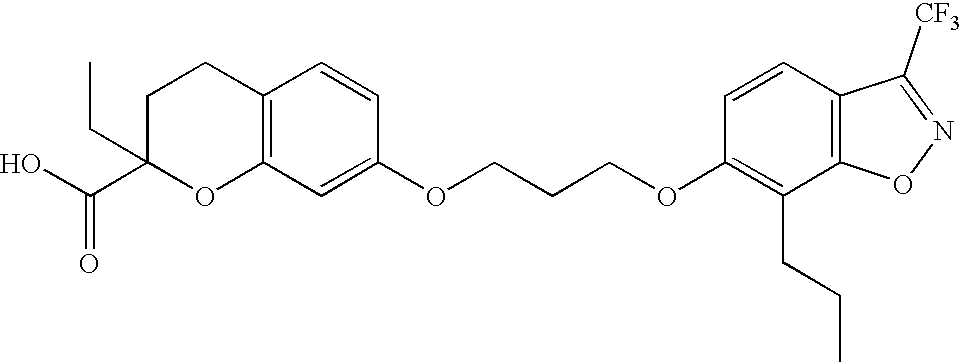Benzopyrancarboxylic acid derivatives for the treatment of diabetes and lipid disorders
- Summary
- Abstract
- Description
- Claims
- Application Information
AI Technical Summary
Benefits of technology
Problems solved by technology
Method used
Image
Examples
example 1
7-(3-(3-Trifluoromethyl-7-propyl-6-benz-[4,5]-isoxazoloxy)propoxy)-2-ethyl-chromane-2-carboxylic Acid
[0176] 33
[0177] Step A: Ethyl 7-hydroxychromane-2-carboxylate 34
[0178] To a large hydrogenation vessel were added ethyl 7-hydroxychromone-2-carboxylate (=ethyl 7-hydroxy-4-oxo-4H-chromene-2-car-boxylate) (675.4 g, 2.88 mol), EtOH 4 liters, conc. hydrochloric acid 40 ml. The resulting suspension was combined with 5% Pd / C 68 g, and subjected to hydrogenation condition (H.sub.2, 40 psi, rt) overnight. The reaction mixture was filtered through a pad of celite to remove the catalyst. The filtrate was concentrated to give thick oily material, which solidified upon standing. Tan solid 630.1 g (98%).
[0179] .sup.1H-NMR (500 MHz, CDCl.sub.3): .delta. 6.89 (d, 1H, J=8.2 Hz), 6.46 (d, 1H, J=2.5 Hz), 6.4 (dd, 1H, J=2.5, 8.2 Hz), 4.9 (brs, 1H), 4.71 (dd, 1H, J=3.1, 7.5 Hz), 4.27 (q, 2H, J=7.3 Hz), 2.76 (m, 1H), 2.7 (m, 1H), 2.25 (m, 1H), 2.18 (m, 1H), 1.3 (t, 3H, J=7.2 Hz).
[0180] Step B: Ethyl 7-(...
example 2
7-(3-(3-(2,2-Dimethylpropyl)-7-propyl-6-benz-[4,5]-isoxazoloxy)propoxy)-2--ethylchromane-2-carboxylic Acid
[0198] 35
[0199] Following the procedures described in Example 1, Steps F-G, the title compound was prepared using 3-(2,2-dimethylpropyl)-7-propyl-6-hydro-xybenzisoxazole (U.S. Pat. No. 6,090,836) instead of 3-trifluoromethyl-7-propyl-6-hydroxybenzisoxazole.
[0200] .sup.1H NMR (500 MHz, CDCl.sub.3): .delta. 7.38 (d, 1H, J=8.7 Hz), 6.96 (d, 1H, J=8.0 Hz), 6.95 (d, 1H, J=8.7 Hz), 6.52 (m, 2H), 4.26 (t, 2H, J=6 Hz), 4.18 (t, 2H, J=6 Hz), 2.89 (m, 2H), 2.83 (s, 2H), 2.72 (m, 2H), 2.32 (m, 1H), 2.31 (p, 2H, J=6 Hz), 1.9-2.05 (m, 3H), 1.7 (sext, 2H, J=7.5 Hz), 1.07 (s, 9H), 1.05 (t, 3H, J=7.3 Hz), 0.97 (t, 3H, J=7.4 Hz). ms: m / e=510 (M+1).
example 3
7-(3-(3-Phenyl-7-propyl-6-benz-[4,5]-isoxazoloxy)propoxy)-2-methylchromane--2-carboxylic Acid
[0201] 36
[0202] Step A: Ethyl 7-(3-(3-phenyl-7-propyl-6-benz-[4,5]-isoxazoloxy)prop-oxy)-2-chromane-2-carboxylate
[0203] The title compound was prepared following the procedure described in Example 1, Step F employing 6-(3-bromopropoxy)-3-phenyl-7-propyl-benzi-soxazole (U.S. Pat. No. 6,090,836) instead of 3-trifluoromethyl-7-propyl-6--hydroxybenzisoxazole, and ethyl 7-hydroxychromane-2-carboxylate instead of ethyl 7-(3-bromopropoxy)-2-ethylchromane-2-carboxylate.
[0204] Step B: 7-(3-(3-Phenyl-7-propyl-6-benz-[4,5]-isoxazoloxy)propoxy)-2--methylchromane-2-carboxylic acid
[0205] The title compound was prepared from ethyl 7-(3-(3-phenyl-7-propyl--6-benz-[4,5]-isoxazoloxy)propoxy)-2-chromane-2-carboxylate following the procedure described in Example 1, Step C employing iodomethane instead of iodoethane, and subsequently hydrolyzed following the procedure described in Example 1, Step G.
[0206] .sup.1...
PUM
| Property | Measurement | Unit |
|---|---|---|
| Electric charge | aaaaa | aaaaa |
| Capacitance | aaaaa | aaaaa |
| Composition | aaaaa | aaaaa |
Abstract
Description
Claims
Application Information
 Login to View More
Login to View More - R&D
- Intellectual Property
- Life Sciences
- Materials
- Tech Scout
- Unparalleled Data Quality
- Higher Quality Content
- 60% Fewer Hallucinations
Browse by: Latest US Patents, China's latest patents, Technical Efficacy Thesaurus, Application Domain, Technology Topic, Popular Technical Reports.
© 2025 PatSnap. All rights reserved.Legal|Privacy policy|Modern Slavery Act Transparency Statement|Sitemap|About US| Contact US: help@patsnap.com



